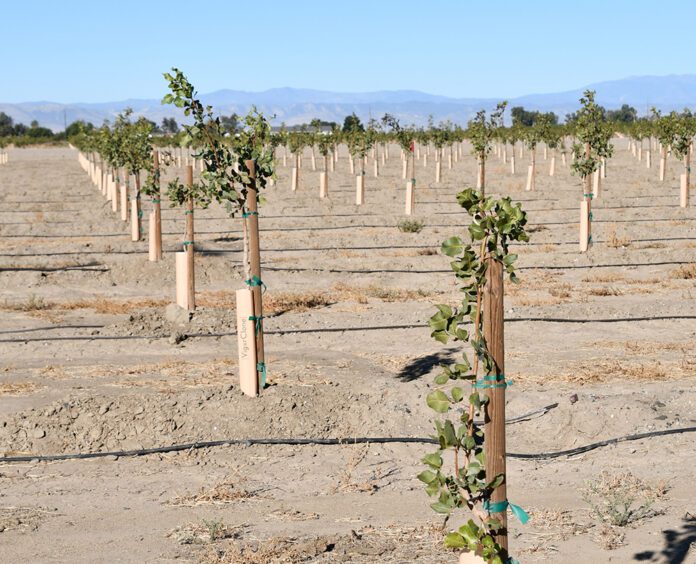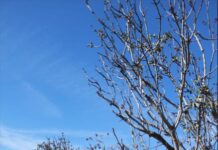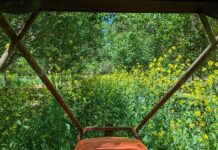
The San Joaquin Valley saw a small break in triple-digit temperatures in mid-July, and it came after 26 consecutive days above 100 degrees F or higher followed by another heatwave. These extreme temperatures can have big impacts on perennial crops like pistachios, which increase in weight in the month of July during nut fill.
Multiple days with temperatures over 105 can stall nut growth, delaying maturity and harvest, according to Stephen Vasquez, CCA and executive director of Administrative Committee for Pistachios.
“The plant is in survival mode at that point and just trying to pull water up to maintain moisture throughout all its foliage and crop,” Vasquez said. “Plants, even if you give them enough water, especially if they’re a full-grown tree, they just can’t pull up enough water to maintain everything.”
Every crop has its own way of dealing with drought stress to conserve water and keep foliage hydrated, Vasquez explained, with heat-stressed trees of any variety often exhibiting burning of leaves, nuts or fruit. He said getting through a long hot spell requires growers to pay attention to the forecast.
“Everybody knew that we were going to get high temps. Nobody knew exactly what it was going to be, but everybody was forecasting that it was going to be over 105 for a long period of time,” Vasquez said.
When growers see those types of forecasts, he said, they need to consider getting ahead of their irrigation.
“If you’re trying to irrigate during that time and you haven’t irrigated beforehand, then you’re already behind,” he said. “The plant really needs moisture in the ground that it can start pulling up to maintain foliage and nuts.”
Based on his own observations, Vasquez said pistachio growers who prepared for the heatwave and irrigated their orchards in advance looked good and had uniform nut fill. However, he noticed some orchards on single-line drip that were suffering from the extreme heat and inadequate irrigation. In those orchards, he said it’s possible they will see some defoliation and sunburn, especially if they have pests like Gill’s mealybug or disease infestations.
Cory Broad, agronomic sales manager at AvidWater, said a challenge with many California tree nuts, especially the more south they’re planted, is a reliance on low-volume drip irrigation systems, which aren’t built with ‘catch up’ in mind.
“If you miss a cycle, you have any down time, you have any issues, or you’re trying to build soil moisture, you’re going to have a really hard time catching up based on the volume that your system is most likely putting out,” Broad said.
That flow rate might average about six gallons an hour per tree for a pistachio block.
“That can meet ETc for mature pistachios in July but would require nearly 300 hours of run time, even in less excessive heat,” he said. “It doesn’t leave a lot of wiggle room to push any more water into the ground, and that’s if the ground will even take it,” he said, adding that irrigation strategies for the July heatwave should have ideally started at the end of May to early June.
While pistachios are more likely to be planted on marginal ground with drip irrigation, crops like almonds are often planted on more prime soil further north where the types of irrigation systems and water capacity vary widely, giving them a better chance during the heat.
But they aren’t exempt from damage either, Broad said.
“When we’re looking at this heat stress on a crop, we’re obviously dealing with it in its immediacy because it’s a very real effect, it’s today, we’re worried about the crop, but we’re also two to three weeks away from starting almond harvest, depending on where you are, and now we have to dry that crop down,” he said. “If we didn’t manage our heat stress well with irrigation, I might not have any soil moisture reserves.”
Broad said tree nuts are luxury consumers, taking water from the top first.
“So, if I don’t have that reserve built, now my heat stress is really going to be next month/ because I don’t have anything left in the tank,” he said.
And that means growers might not really see the impact from this summer’s heat until harvest, which for some might be just a couple weeks away when heat is still going to be an issue.
“Odds are we might still be in triple-digit temperatures during almond harvest, waiting on the nuts to dry. If I can’t run water, yes, I’m going to see the effects of my misdeeds during the month of July,” he said.

Kristin Platts | Digital Content Editor and Social Correspondence
Kristin Platts is a multimedia journalist and digital content writer with a B.A. in Creative Media from California State University, Stanislaus. She produces stories on California agriculture through video, podcasts, and digital articles, and provides in-depth reporting on tree nuts, pest management, and crop production for West Coast Nut magazine. Based in Modesto, California, Kristin is passionate about sharing field-driven insights and connecting growers with trusted information.















